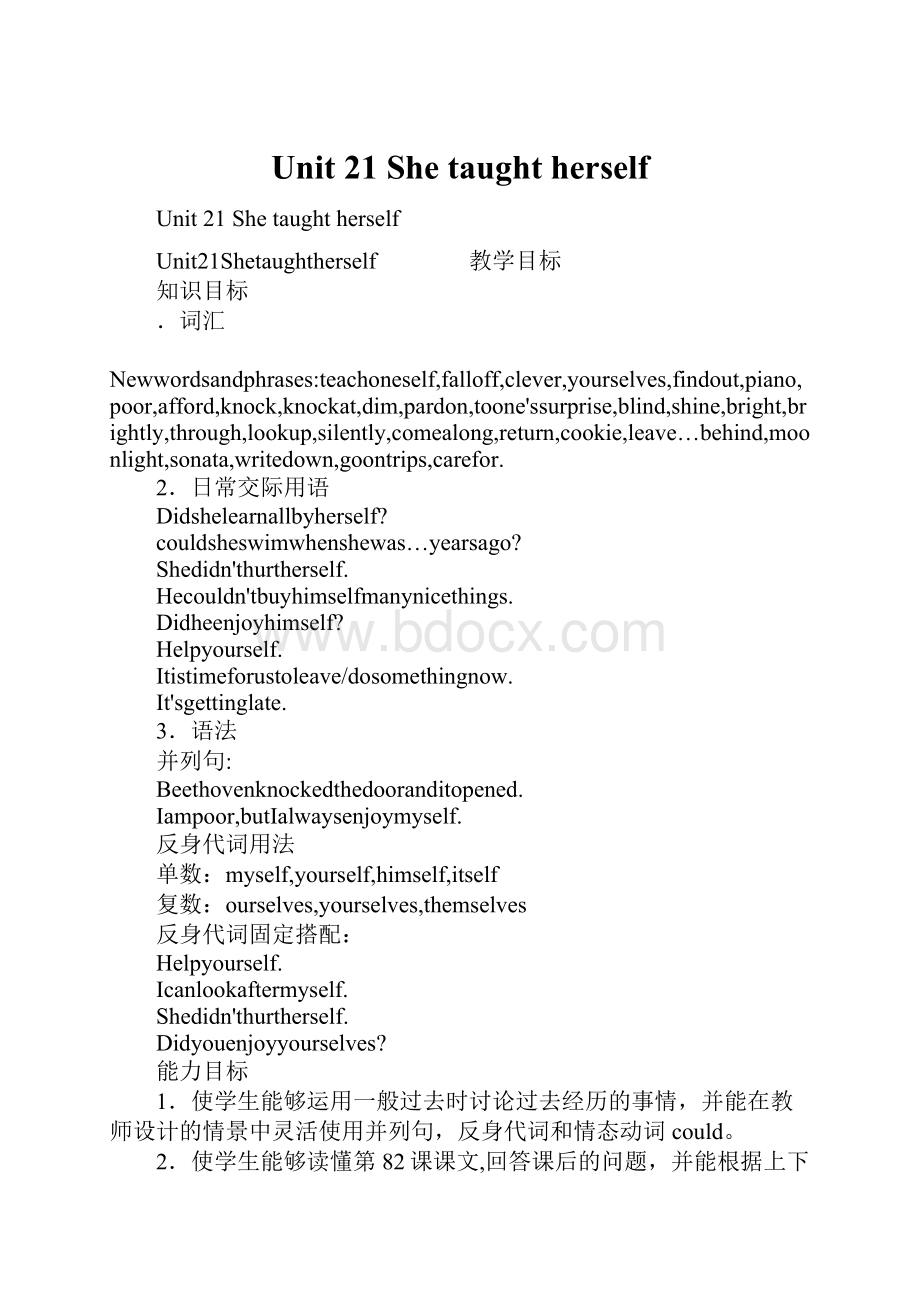Unit 21 She taught herselfWord文档下载推荐.docx
《Unit 21 She taught herselfWord文档下载推荐.docx》由会员分享,可在线阅读,更多相关《Unit 21 She taught herselfWord文档下载推荐.docx(10页珍藏版)》请在冰豆网上搜索。

能力目标
1.使学生能够运用一般过去时讨论过去经历的事情,并能在教师设计的情景中灵活使用并列句,反身代词和情态动词could。
2.使学生能够读懂第82课课文,回答课后的问题,并能根据上下文判断出生词的大意。
3.使学生能掌握本单元的相关语法项目,并能完成口头和笔头的练习。
4.使学生能够听懂与课文难度相当的听力材料。
情感态度目标
通过本单元的教学,使学生在简要了解贝多芬生平的基础上,鼓励他们向贝多芬学习。
学习他博学多才、坚忍不拔、持之以恒,追求自己崇高理想的精神。
青年学生正处于增长知识和才能的黄金时期,不论遇到什么风浪,绝不要半途而废。
相反要扬起风帆,把航船驶向胜利的彼岸。
贝多芬是一位著名的音乐家,他的创作成就极大地深化了音乐艺术的思想性和表现力,对后世有着深远的影响。
在本单元的教学过程中教师可选用一些贝多芬的代表作,在课前或课后播放给学生听,以陶冶他们的情操,提高他们对名曲的欣赏能力。
教学建议
教学内容分析
本单元是以讨论过去的经历为主要话题,同时学习反身代词及并列句的用法,还包括情态动词can/could的用法。
在第81课中主要通过听,说,谈论等几种方式使学生能正确运用情态动词can/could和过去式讨论过去发生的事件。
在第82课中主要是通过一篇阅读来提高学生的阅读能力。
在第83课中主要是通过对贫富两个人的介绍和一个对话使学生掌握并列句和几个反身代词固定搭配。
在第84课中练习形式多样,主要是对本单元内容进行综合练习。
教学重点分析
本单元的重点语法是并列句和反身代词,单元的教学功能项目也是围绕这些展开的。
Lesson81的对话建立在两幅图片的基础上,就Lily的过去经历进行问答,引出反身代词的用法。
Lesson83中的介绍mr.more和mr.Little两位先生的短文,通过对各人本身过去经历的提问,进一步学习反身代词和一般过去时态。
Lesson82的课文,我们可带着如下问题去学习:
whatdoyouknowaboutBeethoven?
全篇课文以过去的时态进行介绍的,我们应学会用过去时态去写过去的事情或人物。
Lesson84的对话,我们要能够模仿运用,同时学会写“Thank-younote”。
关于介绍过去发生事情的建议
1.图片提示
Theteachercanshowsomepicturesofthestudentsatdifferentagesontheblackboardandaskthesequestions:
A.whatisthegirl’sname?
whatisshedoing?
whatcouldshedowhenshewasfiveyearsold?
B.whoistheboy?
whathappenedatthatmoment?
Howdidhefinishthetrip?
2.教师可以通过简笔画的形式组织学生根据图画内容编写下列对话:
A:
canyouplaycomputergames,mary?
B:
yes,Ican.
A:
couldyouplaycomputergameswhenyouwerefiveyears?
B:
No,Icouldn’t.
canyouplayviolin?
couldyouplaytheviolinwhenyousix?
No,Icouldn’t.Ibegantolearntoplaytheviolinlastyear.
Howdidyoulearnit?
Ilearneditbymyself.
有关并列句的教学建议
教师先写出一些句子,让学生分析,找出并列句的基本特点,最后由教师归纳这些并列连词的用法。
然后让学生自己做一些练习,加强对并列句的理解。
现提供两例:
1.将下列用and或but连接.
A.Iampoor.Iamveryhappy.
B.IlikeEnglish.Iamgoodatit.
c.myfathertoldmarythisstory.marybecameinterestedinit
D.Hefelloffthewall.Hedidn’tbreakhisarms.
2.判断下列句中and或but的用法是否正确.
A.Icanswim,andIamgoodatit.
B.Iwantedtohaveacupofcoffee,andtheboypassedmeanorange.
c.Theboyisverycleverbuthecananswerthequestioneasily.
反身代词的教学建议
(1)建议教师将反身代词归纳总结如下,便于学生记忆。
单数:
myself,yourself,himself,herself,itself
复数:
提醒学生注意单数复数的区别,-self和-selves分别用不同的颜色标记。
教师先和学生一起找出所学过的含有反身代词的短语。
然后编制练习或对话让学生反复操练。
反身代词固定搭配有:
enjoyoneself,lookafteroneself,helponeselfto...,hurtoneself,saytooneself,loveoneselfinthebeautifulmusic,buyoneselfsth.,teachoneself,allbyoneself,leavesb.byourselves等。
教师可通过多种办法让他们多练多用。
条件好的可利用多媒体让学生进行模仿练习。
(2)教师可以投影片出示一段介绍,然后对学生进行提问.
IamTom.Iamthirty.Icanlookaftermyself.IlikeEnglish.Itaughtmyself.Ilikeplayingfootballwithmyclassmatetoo.whenweplayit,weenjoyourselvesverymuch.yesterday,Ihurtmyselfinthegame,butthegamewasveryexciting.Ilostmyselfinit.Ididn’tfeelanypainuntilIgothome.
Questions:
A.canTomlookafterhimself?
yes,hecan.
B.HowdidTomlearnEnglish?
Hetaughthimself.
c.Doesheenjoyhimselfverymuchwhenheplaysfootball?
yes.
D.Didhehurthimselfinthegamelasttime?
F.whydidn’thefeelanypainuntilhegothome?
Helosthimselfinthegame.
阅读教学的建议:
(1)建议教师在阅读之前先向同学介绍贝多芬的背景知识及一些相关的音乐方面的词汇,使学生熟悉课文内容。
教师可以设计问题如下:
1.Doyoulikemusic?
2.whatkindofmusicdoyoulike?
3.HaveyouheardaboutBeethoven?
4.canyoutellussomeofhisfamouswork?
教师可以请学生听一首贝多芬的《月光曲》使学生身临其境,使学生对课文感兴趣。
教师还可结合语文课本中的月光曲进行介绍,这样学生对课文的意思就理解了。
(2)本课生单词较多,建议教师设计一些有关的练习,多种手段帮助学生猜测生词的意义,突破难点:
1.wecan’taffordtobuytickets.Theticketsisveryexpensive.Idon’thaveenoughmoneytobuythetickets.
2.Iampoor.Iamnotrich.Idon’thaveenoughmoney.
3.Theteachersaysnomore.Theteacherstopstalking.
4.Todayisbright.Thereisnotanycloudinthesky.
5.Tohissurprise,hefindshemadeabigmistake.
Hemadeabigmistakethatmakeshimsurprised
6.Theylostthemselvesinthebeautifulmusic.Theylistenedtothemusicanddidn’tcareforotherthings.
(3)教师还可利用简笔画和课文的关键词,让学生根据图和词汇的提示复述整个故事的概况。
能力训练建议
1.通过老师适当的讲解,学生有系统的练习反身代词myself,ourselves,yourself,yourselves,himself,herself,itself,themselves的用法。
2.情态动词could在不同的语言环境中有不同的含义。
①表示请求或建议,使语气委婉。
②表示can的过去式。
通过口头和书面练习,掌握它的不同用法。
3.第82课讲述的是贝多芬著名的《月光奏鸣曲》。
文字流畅、易读、易懂。
老师首先要求学生熟读或背诵课文内容,然后请他们加以重新组织,把课文的主要内容用英文加以复述。
4.从本单元开始,课文增加了一项写作训练,教师应让学生根据课文提示认真练习,以便提高实际运用语言的能力。
反身代词
反身代词又称自身代词,顾名思义,就是指动作反射到动作执行者本身,或是在句中起强调作用,以加强句子的语气。
反身代词的构成
反身代词是由形容词性物主代词或宾格代词加-self或-selves构成。
反身代词单数以-self结尾,复数以-selves结尾;
第一、二人称是形容词性物主代词加self构成,第三人称是宾格代词加self(selves)构成。
详见下表:
第一人称
第二人称
第三人称
单数
myself
yourself
itself
himself
herself
复数
ourselves
yourselves
themselves
反身代词的用法
当一个句子的主语、宾语是同一个人时,常用反身代词作宾语。
1.作动词的宾语。
如:
–DidyouenjoyyourselfintheparkonSunday?
–yes,wedid.
–couldhebuyhimselflotsofpresents?
–No,heisverypoor.Buthisfriendsoftengivehimpresents.
注:
反身代词作动词宾语时,常见的动词有:
enjoy,help,hurt,know,wash,lookafter,teach等。
2.作介词的宾语。
–Ifinishedtheworkbymyself.
–you’regreat!
3.其他用法:
反身代词还可以作宾语的同位语。
I'
llspeaktotheteacherhimself.Idon’twantsomeoneelseknowit.
也可作表语用。
Sheisnotherselftoday.Shehastostayathome.Shecan’tgotoschool.
注意事项:
反身代词一般无所有格,也不能放在of短语(表示所属)后,“某人自己的”可用one'
sown表达。
–I'
dliketohaveacarofmyown.
–Soyoumustworkhardtoearnmuchmoney.
反身代词本身通常不能作主语,但可以放在并列主语后作第二主语。
mybrotherandmyselfbothlikeEnglishverymuch.weoftentalktoeachotherinEnglishafterclass.
反身代词与其所强调反身的成份在人称、数等方面要保持一致。
wemetLiminghimselfontheplayground.wetoldhimthegoodnews.
Heboughthimselfacoatwithhisfirstwage.Thenhesenttheresttohismother.
并列句
由两个或两个以上的简单句并列连接起来的句子叫做并列句。
并列句中的各个简单句意义同等重要,联系密切。
它们平行并列,相互之间没有从属关系。
并列句的基本句型是:
简单句+并列连词+简单句。
不同的并列连词表示不同的关系。
联合关系:
常用的连词有and。
Beethovenknockedatthedooranditopened.Inthedimcandlelightagirlwassittingbeforeapiano.
转折关系:
常用的连词有but。
IcanbuymyselflotsofnicethingsbutIdon'
thavemanyfriends.我可以买到许多漂亮的东西但是我没有许多的朋友。
在完成并列句的时候,容易在两个基本的简单句的时态把握上产生错误,读者一定要分清楚它们各自所处的时间背景。
在例句1中,贝多芬敲门是一个典型的过去时间发生的事情,紧随其后的门开了也应该是同一时间的事件;
因此,并列句往往存在两个简单句之间的时态呼应问题。
Lesson81教学设计方案
Teachingobjectives:
Grammar:
1.reflexivepronouns
singular:
plural:
2.pasttenseformofcan→could
Languagefocus:
falloff,teachoneself,hurtoneself,learnbyoneself,writedown
Properties:
Tape-recorder,overheadprojector
TeachingProcedures:
I.organizingtheclass
1.Askthestudentstogetreadyforclass.
2.Greetingsbetweenthestudentsandtheteacher.
3.Adutyreport.
II.Revision
callout2-3studentstoretellthestoryofthetigerandthemonkeylearnedinthelastperiod.
III.Leading-in
1.Tellthestudentstheyaregoingtotalkaboutwhattheycoulddowhentheywerelittle.
2.AskstudentA:
youcanrideabikenow.couldyourideabikewhenyouwere5yearsold?
Helpthestudentstoanswer“yes,Icould,”or“No,Icouldn’t.”
3.AskstudentB,cinthesameway.
4.Pointoutthat“could”isthepasttenseformof“can”.
IV.Practice
1.Pairwork:
Askthestudentstotalkwiththeirpartnersandfindoutwhattheirfriendscoulddoattheageof4.writedowntheiranswersontheformonPage31.
2.Report:
Askthestudentstoreporttheirpartnersabilitiesattheageof4.
V.Readandact
1.Presentation
Drawapictureofjimontheblackboard.
Say“Thisisjim.jim’sathome.Hisfatherisatwork.Hismotherisshopping.”Repeat,thenask“who’sathome?
jim.Ishisfather/motherathome?
No,jim’salone.He’sallbyhimself.”Practise“byhimself”.
DrawapictureofBettyontheblackboard.TalkaboutBettyinthesameway,using“Herfather/mother”and“She’sbyherself”.
Asktwostudentstoopenthedoor.Thenaskoneofthemtocloseit:
“Pleaseclosethedoorbyyourself.”Repeatwithotherstudentsandothertask.Introduce–“selves”inthesameway.
Tellthestudents:
“Iamgoingshopping.IwanttobuyLiLeisomeshoes.IwanttobuyweiHuaahat.IwanttobuyHanmeimeiadress.Iwanttobuymyselfahat.“Ask”whatdoIwanttobuyLiLei/weiHua/Hanmeimei/myself?
Getthestudentstosayyouwanttobuyyourselfsomeshoes/…Pointouttheuseof
“myself”.Tellthestudents:
“youaregoingshopping.youwanttobuyyourfriendandyourselfsomething.”
T:
Goaroundtheclass,asking“whatdoyouwanttobuyyourfriend/yourself?
whatdoeshe/shewanttobuyhis/herfriend?
whatdoeshe/shewanttobuyhimself/herself?
”
2.Studentsbook:
Page31PartoneSpeechcassetteLesson81.
3.Lookatthepictures,askwhat’sLilydoing?
4.Playthetapeofthedialogueforthestudentstolistenandrepeat.
5.Explainthelanguagepoints.
falloff从……上摔下来
①Becareful!
Don’tfallofftheladder.
②–Hefelloffthehorseandhurthimself.
–I’msorrytohearthat.Ihopehe’llbewellsoon.
hurtoneself伤着自己
①–Didhehurtherselfthistime?
–No,hedidn’t.
teachoneself=learnbyoneself自学
–Lilytaughtherselfswimming.
–She’sveryclever.
6.Askthestudentstorecitethedialogue.
VI.Exercisesinclass
用适当的反身代词填空。
1.Help________tosomefish,LilyandLucy.
2.jimisoldenoughtolookafter________.
3.weallenjoyed________intheweek-longNationalDayholiday.
4.Ihopenotmanypeoplehurt________intheaccident.
5.mymothertaught_________Englishattheageof40.
6.myparentswenttotravelandleftmeby_________athome.
keys:
1.yourselves
2.himself
3.ourselves
4.themselves
5.herself
6.myself
VII.Homework
1.Finishexercisesonpage97.
2.makesentenceswithreflexivepronouns.
VIII.Summary
写出下列动词的过去式。
1.do________
2.hurt________
3.is________
4.can________
5.teach________
6.learn________
7.fall________
8.swim________
9.sing________
10.ski________